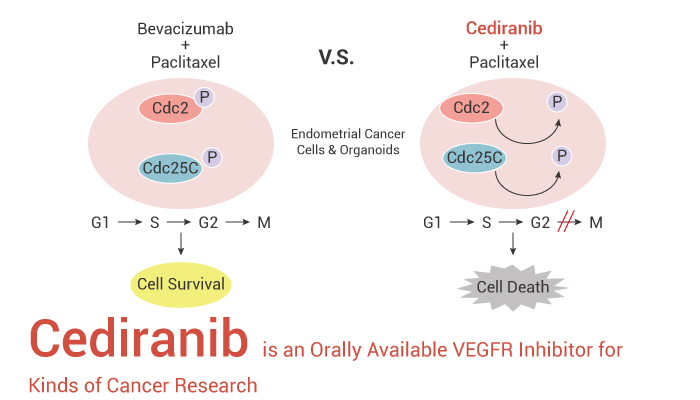Cediranib is a tyrosine kinase inhibitor that has shown promise in the treatment of cancer. It works by inhibiting the kinase activity of both C-Raf and B-Raf, leading to downregulation of MEK and ERK activities in tumor cells. Additionally, it suppresses angiogenesis by inhibiting the activity of vascular endothelial growth factor receptor (VEGFR) and platelet-derived growth factor receptor (PDGFR) in endothelial cells.
Cediranib (AZD2171) is a highly potent, orally available VEGFR tyrosine kinase inhibitor with IC50s of <1, <3, 5, 5, 36, 2 nM for Flt1, KDR, Flt4, PDGFRα, PDGFRβ, c-Kit, respectively. So far, Cediranib has been studied in various types of cancer, including kidney cancer and ovarian cancer. In the treatment of kidney cancer, Cediranib has been approved and shown to be effective. However, its use in ovarian cancer has also been explored and has shown promising results.

Cediranib is an Orally Available VEGFR Inhibitor for Kinds of Cancer Research
In ovarian cancer, Cediranib has demonstrated activity both as monotherapy and in combination with other treatments. In a phase III trial, the addition of Cediranib to chemotherapy and maintenance treatment resulted in a significant improvement in progression-free survival. So Cediranib may enhance the effectiveness of standard treatments for ovarian cancer.
Furthermore, Cediranib has been found to have advantages over other anti-angiogenic agents, such as Bevacizumab. It has been shown to induce cell cycle abrogation and synergize with chemotherapy, leading to increased cell death. This suggests that Cediranib may have a more targeted and potent effect on cancer cells.
In summary, Cediranib is a promising drug in the treatment of cancer, particularly in kidney cancer and ovarian cancer. Its ability to inhibit kinase activity and suppress angiogenesis makes it an effective option for patients. Further research is needed to fully understand its potential benefits and limitations in different types of cancer.
References:
[1] Bi J, et al. Pharmaceuticals (Basel). 2021 Jul 16;14(7):682.
[2] Wedge SR, et al. Cancer Res. 2005 May 15;65(10):4389-400.